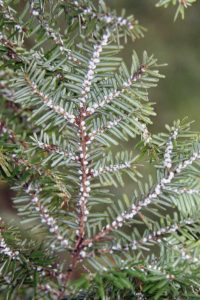 The hemlock woolly adelgid (Adelges tsugae) (HWA) is native to parts of Asia and was first discovered in New York in 1985. It is in the family Adelgidae, which is related to aphids. The adelgid uses long mouth parts to extract sap and nutrients from hemlock foliage, this prevents free growth, causing needles to discolor from deep green to grayish green, and to drop prematurely. The loss of new shoots and needles seriously impairs tree health. Infestation is usually fatal to the host after several years. Valued plantings of the shade-loving eastern hemlock (Tsuga canadensis) can be ravaged by the hemlock woolly adelgid, and the natural stands of hemlock in the forests and parks in upstate New York would be greatly affected if the pest spreads to those locations. The wind, birds, other wildlife and the movement of infested host material (wood) by humans are all factors in the dispersion of the adelgid.
The hemlock woolly adelgid (Adelges tsugae) (HWA) is native to parts of Asia and was first discovered in New York in 1985. It is in the family Adelgidae, which is related to aphids. The adelgid uses long mouth parts to extract sap and nutrients from hemlock foliage, this prevents free growth, causing needles to discolor from deep green to grayish green, and to drop prematurely. The loss of new shoots and needles seriously impairs tree health. Infestation is usually fatal to the host after several years. Valued plantings of the shade-loving eastern hemlock (Tsuga canadensis) can be ravaged by the hemlock woolly adelgid, and the natural stands of hemlock in the forests and parks in upstate New York would be greatly affected if the pest spreads to those locations. The wind, birds, other wildlife and the movement of infested host material (wood) by humans are all factors in the dispersion of the adelgid.
From the first discovery of the hemlock woolly adelgid in the Hudson Valley in the 1980’s, the insect has spread north and west to the Catskills, the Capital Region and even the Finger Lakes and other parts of Western New York. Currently 25 New York counties are infested with the hemlock woolly adelgid.
Anytime between February and May is good for sampling, though snow on hemlocks usually precludes starting surveys in the middle of winter. The picture above shows the underside of an infested branch. You are looking for the white woolly ovisacs. If you find evidence during a hike, Cornell set up an online reporting, for both positive and negative reports that you are encouraged to use. They share the results with DEC and USFS annually. Just click on the link above.
Our thanks to Gene for keeping this pest on our radar, and to Todd Bittner at Cornell for sharing the survey link and the picture above with us.
